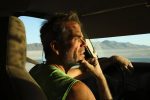“If human beings really were able to take the long view – to consider seriously the fate of civilization decades or centuries after our deaths – we would be forced to grapple with the transience of all we know and love in the great sweep of time. So we have trained ourselves, whether culturally or evolutionarily, to obsess over the present, worry about the medium term and cast the long term out of our minds, as we might spit out a poison.” – Nathanial Rich, “Losing Earth”

With the current right-before-our-eyes devastation of the planet due to global warming, it’s especially urgent to read this week’s special issue of the Sunday New York Times Magazine called, “Losing Earth: The Decade We Almost Stopped Climate Change.” It’s Nathanial Rich’s exhaustive account of the period from 1979–1989, when scientists knew we were on a deadly course with carbon emissions, and Republicans and Democrats agreed that urgent action had to be taken. But then nothing happened, and here we are: with accelerating heat, drought, fires, floods, and melting icebergs.
Last week I couldn’t help but be reminded of a similar folly of inaction—albeit on a smaller scale—when City Council performed a disheartening dereliction of duty. Instead of taking the success of our test roundabout (at the five-way intersection of Catalina, Los Robles and Camino del Mar), and rolling it out to needed intersections as was originally intended five years ago, council ruminated on a proposal from the city to spend $750,000 to make the existing roundabout permanent. Say what?
I won’t even get into the folly of spending three quarters of a million dollars to decorate an intersection with marginal impact to the community, except to say the city proposed patterned brickwork on the five pedestrian crosswalks to “differentiate it” from the street. Patterned crosswalks? What, are we putting in a Bijan store? Talk about an overwrought solution for an intersection without a problem.
Thankfully, council rejected the proposal and sent staff back to the drawing board with its original budget of $300,000. But that’s still $300,000 too much. Let the neighborhood decorate it, like they do in Portland. Put in a community teahouse.
I don’t fault city staff. They’re just doing their job, although how they can inflate a budget by 150 percent should raise some eyebrows. But what really bugged me was not a single voice on council said that it was time to test a roundabout at a real intersection, where it is needed. One said only that we should “keep it in mind.” Many of us have for five years now, when the city won a $200,000 grant and funded the “Enhanced Mobility and Complete Streets Transition Plan.” This document was and remains the best plan we have for improving traffic flow and providing multi-modal solutions for generations to come. I encourage you to look it up on the city’s website. Sadly, none of it has been acted upon.
Glenneyre was originally proposed for roundabouts because it’s the busiest arterial we control, with some 11,700 cars per day. Initial test intersections considered were far from downtown, like Caliope and Thalia, where cars are routinely backed up because no one knows who’s up first. A roundabout is a clear traffic signal for everyone to yield and turn right, often without stopping. That lowers engine wear, noise pollution and mishaps while increasing flow and efficiency. Traffic studies also show that roundabouts work even when lanes are reduced.
But one council person concluded the debate by declaring that roundabouts won’t work anywhere else in town, and that the issue was essentially D.O.A. They offered this bit of science to their rationale: “How many areas have that big blob of cement that would work? When it was proposed on Glenneyre, it was gonna be a nightmare, and it wouldn’t improve traffic flow.”
Except that flies in the face of testimony from experts like Steve Brown, a traffic consultant from Fahr & Peers. He has studied roundabouts for 20 years, and stood before council five years ago, confident that roundabouts on Glenneyre would be a game changer. So who is right? The only way to find out is to test one.
If Glenneyre worked, the study also recommended portions of Park Avenue (possibly at Third Street). We could also install at other needed locations like Laguna Canyon Road at El Toro, or Broadway and Forest to create a real, functional “Village Entrance.” They’ve been installed with great success around the world, as well as in Dana Point, San Clemente, Costa Mesa and Huntington Beach.
Like climate change, we know that the march of automobile madness is upon us, choking out our quality of life and eventually our home values, and will grow exponentially in the coming years with all the new housing starts in South Orange County.
When will we feel the urgency to address our problems and make meaningful and tactical changes that will add up to something? I encourage you to ask tough questions about real traffic solutions this election season, and hopefully use the “Enhanced Mobility and Complete Streets Transition Plan” as your playbook. Your life depends on it.
Billy Fried hosts “Laguna Talks” on Thursday nights at 8 p.m. on KX93.5 and can be reached at [email protected].




